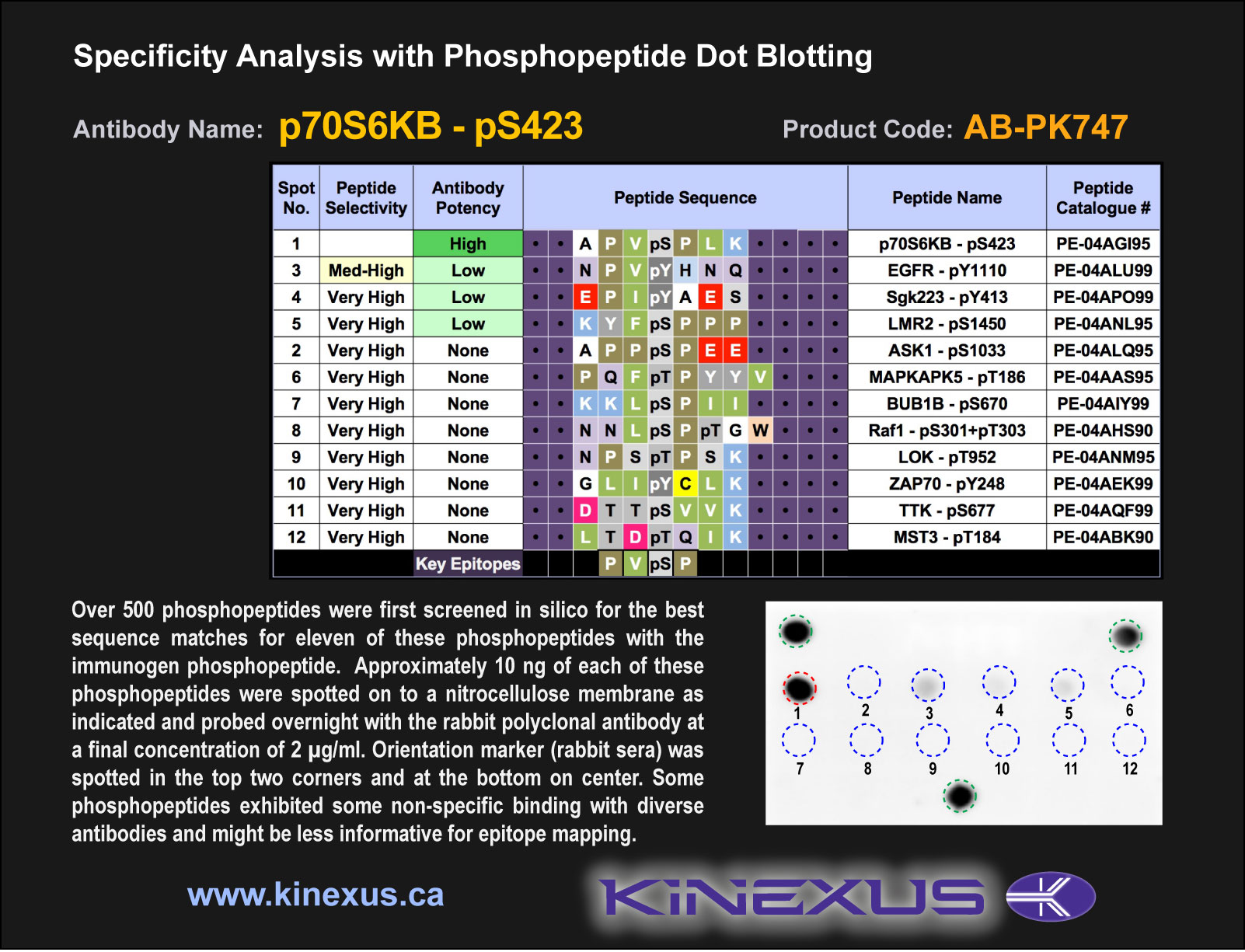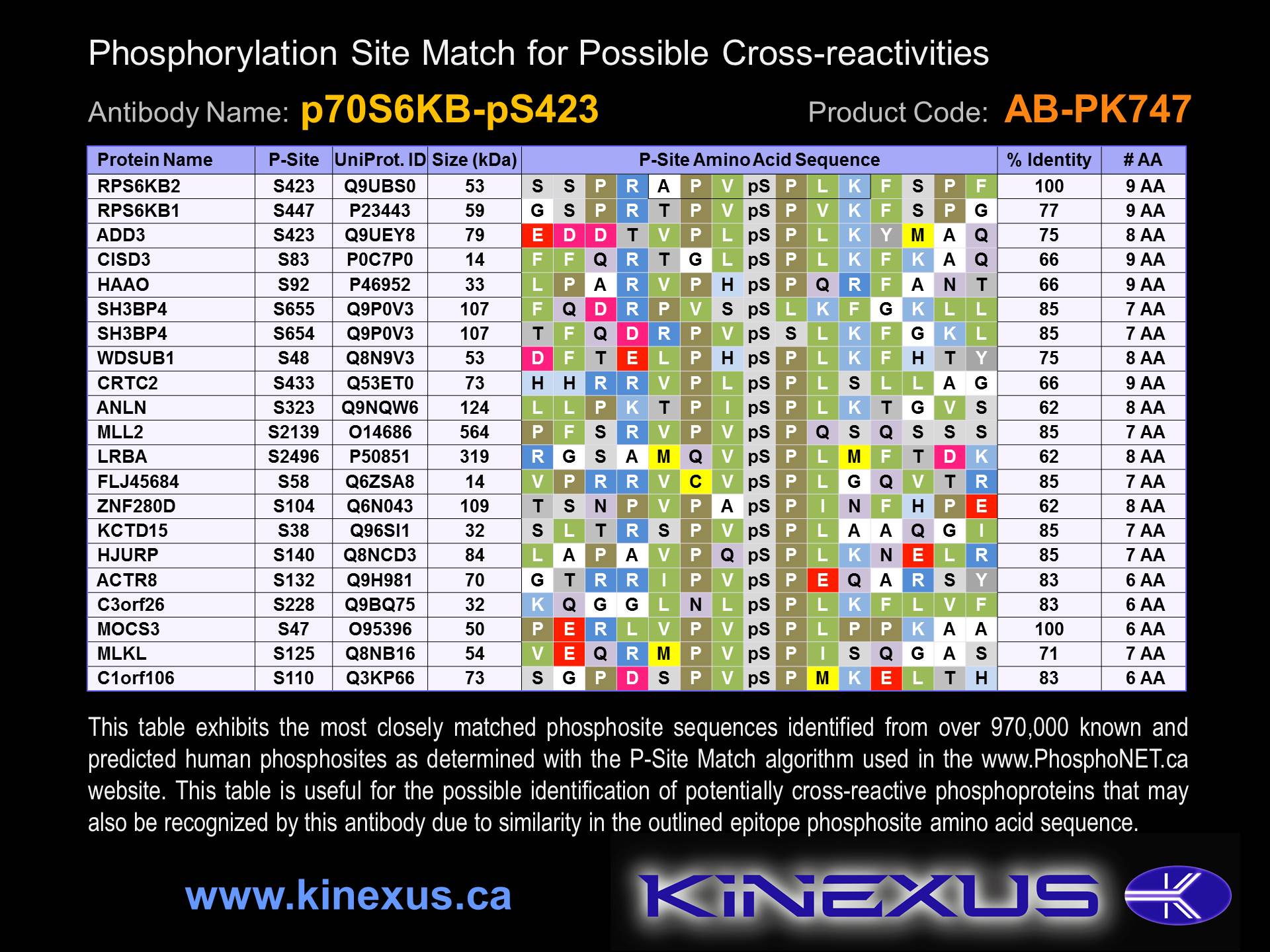Product Name: p70S6KB-pS423
Product Number: AB-PK747
| Size: | 25 µg | Price: | 89.00 | |
| $US |
Target Full Name: Ribosomal protein S6 kinase beta-2; Ribosomal protein S6 kinase 2
Target Alias: 14 beta; KLS; KS6B2; p70-beta; p70-beta-1; p70-beta-2; RPS6KB2; S6 kinase-related kinase; S6K2; S6K-beta 2; SRK; STK14B; SRK; ENSG00000175634
Product Type Specific: Protein kinase phosphosite-specific antibody
Antibody Code: PK747
Antibody Target Type: Phosphosite-specific
Antibody Phosphosite: S423
Protein UniProt: Q9UBS0
Protein SigNET: Q9UBS0
Antibody Type: Polyclonal
Antibody Host Species: Rabbit
Target Alias: 14 beta; KLS; KS6B2; p70-beta; p70-beta-1; p70-beta-2; RPS6KB2; S6 kinase-related kinase; S6K2; S6K-beta 2; SRK; STK14B; SRK; ENSG00000175634
Product Type Specific: Protein kinase phosphosite-specific antibody
Antibody Code: PK747
Antibody Target Type: Phosphosite-specific
Antibody Phosphosite: S423
Protein UniProt: Q9UBS0
Protein SigNET: Q9UBS0
Antibody Type: Polyclonal
Antibody Host Species: Rabbit
Antibody Immunogen Source: Human p70S6KB (RPS6KB2) sequence peptide Cat. No.: PE-04AGI95
Antibody Immunogen Sequence: APV(pS)PLK(bA)C
Antibody Immunogen Description: Corresponds to amino acid residues A420 to K426; In the C-terminal fifth of the kinase
Antibody Immunogen Sequence: APV(pS)PLK(bA)C
Antibody Immunogen Description: Corresponds to amino acid residues A420 to K426; In the C-terminal fifth of the kinase
Production Method: The immunizing peptide was produced by solid phase synthesis on a multipep peptide synthesizer and purified by reverse-phase hplc chromatography. Purity was assessed by analytical hplc and the amino acid sequence confirmed by mass spectrometry analysis. This peptide was coupled to KLH prior to immunization into rabbits. New Zealand White rabbits were subcutaneously injected with KLH-coupled immunizing peptide every 4 weeks for 4 months. The sera from these animals was applied onto an agarose column to which the immunogen peptide was thio-linked. Antibody was eluted from the column with 0.1 M glycine, pH 2.5. Subsequently, the antibody solution was neutralized to pH 7.0 with saturated Tris.This antibody was also subject to negative purification over phosphotyrosine-agarose.
Antibody Modification: Unconjugated. Contact KInexus if you are interest in having the antibody biotinylated or coupled with fluorescent dyes.
Antibody Modification: Unconjugated. Contact KInexus if you are interest in having the antibody biotinylated or coupled with fluorescent dyes.
Antibody Concentration: 1 mg/ml
Storage Buffer: Phosphate buffered saline pH 7.4, 0.05% Thimerasol
Storage Conditions: For long term storage, keep frozen at -40°C or lower. Stock solution can be kept at +4°C for more than 3 months. Avoid repeated freeze-thaw cycles.
Product Use: Western blotting | Antibody microarray
Antibody Dilution Recommended: 2 µg/ml for immunoblotting
Antibody Potency: Very strong immunoreactivity with immunogen peptide on dot blots.
Antibody Species Reactivity: Human
Antibody Positive Control: The observed molecular mass of the processed target protein on SDS-PAGE gels is reported to be around 53-65 kDa.
Storage Buffer: Phosphate buffered saline pH 7.4, 0.05% Thimerasol
Storage Conditions: For long term storage, keep frozen at -40°C or lower. Stock solution can be kept at +4°C for more than 3 months. Avoid repeated freeze-thaw cycles.
Product Use: Western blotting | Antibody microarray
Antibody Dilution Recommended: 2 µg/ml for immunoblotting
Antibody Potency: Very strong immunoreactivity with immunogen peptide on dot blots.
Antibody Species Reactivity: Human
Antibody Positive Control: The observed molecular mass of the processed target protein on SDS-PAGE gels is reported to be around 53-65 kDa.
Antibody Specificity: High-very high
Related Product 1: p70S6KB-pS423 blocking peptide
Related Product 2: RPS6 (230-238) KinSub - 40S ribosomal protein S6 (K230-R238, human) peptide; p70S6K protein kinase substrate peptide
Related Product 3: S6KASubtide - p70S6K (RPS6KB1) protein kinase substrate peptide
Related Product 4: GSK3b (3-12) KinSub - Glycogen synthase kinase 3-beta (GSK3b) N-terminus (G3-E12, human) peptide; Akt protein kinase substrate peptide
Related Product 1: p70S6KB-pS423 blocking peptide
Related Product 2: RPS6 (230-238) KinSub - 40S ribosomal protein S6 (K230-R238, human) peptide; p70S6K protein kinase substrate peptide
Related Product 3: S6KASubtide - p70S6K (RPS6KB1) protein kinase substrate peptide
Related Product 4: GSK3b (3-12) KinSub - Glycogen synthase kinase 3-beta (GSK3b) N-terminus (G3-E12, human) peptide; Akt protein kinase substrate peptide
Scientific Background: p70S6Kb (RPS6KB2) is a protein-serine/threonine kinase that is a member of the AGC group of protein kinases in the RSK family, and p70 subfamily. It acts downstream of mTOR signalling in response to growth factors and nutrients to promote cell proliferation, cell growth and cell cycle progression. It controls protein synthesis through phosphorylation of EIF4B, RPS6 and EEF2K, and contributes to cell survival by repressing the pro-apoptotic function of BAD. Upon mitogenic stimulation, phosphorylation by the mammalian target of rapamycin complex 1 (mTORC1) leads to dissociation from the EIF3 complex and activation. The active form then phosphorylates and activates several substrates in the pre-initiation complex, including EIF2B and EIF4B. It also regulates translation initiation by phosphorylating a negative regulator of EIF4A, PDCD4, and targeting it for ubiquitination and subsequent proteolysis. It promotes initiation of the pioneer round of protein synthesis by phosphorylating POLDIP3/SKAR. In response to IGF1, it activates translation elongation by phosphorylating EEF2 kinase (EEF2K), which leads to its inhibition and activation of EEF2. It negatively regulates mTORC2 by phosphorylating RICTOR, resulting in the inhibition of mTORC2 and AKT1 signalling. It mediates cell survival by phosphorylating the pro-apoptotic protein BAD and suppressing its pro-apoptotic function. It phosphorylates mitochondrial URI1 leading to dissociation of a URI1-PPP1CC complex. It mediates TNF-alpha-induced insulin resistance by phosphorylating IRS1 at multiple serine residues to accelerated degradation of IRS1.
Figure 1. Epitope mapping of p70S6KB-pS423 antibody with similar phosphopeptides on dot blots.
Figure 2. Identification of phosphosites related to p70S6KB-pS423.
© Kinexus Bioinformatics Corporation 2017



